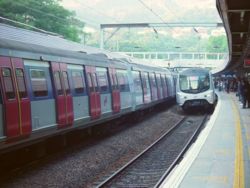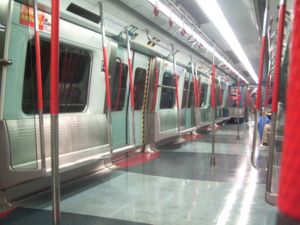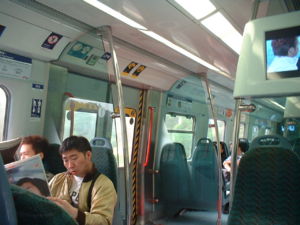KCR East Rail
|
| ||
| Opening Date | 10 October 1911 | |
| Stations | 14 | |
| Number of trains | 37 | |
| Service Area | North, Tai Po, Sha Tin, Yau Tsim Mong, Sham Shui Po, Kowloon City | |
The East Rail (東鐵) is one of three lines of the KCR network in Hong Kong. It starts at East Tsim Sha Tsui in Kowloon and ends at Lo Wu, the land border with Shenzhen. The route used to be the only metro line of the KCRC, but following the construction of the West Rail, it was designated the East Rail to avoid confusion.
The same railway is used for passenger and freight services crossing the border with Shenzhen to various cities in mainland China, including Guangzhou, Shanghai and Beijing. These longer-distance passenger services start/end at Hung Hom. The line is generally double-track and electrified, except for certain goods sheds. Immigration and customs facilities are available at Hung Hom (for through-train passengers) and Lo Wu (for border interchange passengers) stations.
History
The construction of the East Rail started in 1910, then as the Kowloon-Canton Railway. The part of the railway located in Hong Kong was referred to as the "British Section", while the remaining route to Canton (now Guangzhou) was called the "Chinese Section", now the Guangzhou-Shenzhen Railway. Initially, service was only from Yau Ma Tei station to Fanling station with a tunnel through Beacon Hill.
After the "Chinese Section" was completed, through-train service became available to Canton, through Sham Chun (now Shenzhen). Lo Wu station also serves as a border crossing, with a bridge across the Sham Chun River, the natural border between Hong Kong and China. Trains had to stop at Lo Wu station after Communist China closed the border and suspended the through-train service in 1949.
The line was generally single track, with a passing loop at each station.
The line was originally built with narrow gauge tracks, but just before opening standard gauge track was laid and the original tracks were used to build a branch line, the Sha Tau Kok Railway from Fanling to Sha Tau Kok. This branch was unsuccessful and closed on 1 April 1928 following the opening of a road that ran parallel to the tracks.
Through the years, more stations continued to be added to the line. Sheung Shui station was opened in the 1930s, and Ma Liu Shui (now University) station opened in 1955.
The development of the towns along the line began to grow immensely during the 1970s, prompting a redevelopment of the Kowloon-Canton Railway. The original Kowloon station terminus at Tsim Sha Tsui was too small and had no room for expansion, so a new terminus site was chosen in Hung Hom, then known as Kowloon station. The new Kowloon station replaced the old one in 1974. Today, the clock tower is the only structure left from the old terminus, and is a landmark near the Cultural Centre, Space Museum and the Star Ferry pier. Some six pillars are relocated to Urban Council Centennial Park in TST East. A big bell was stored at Ho Tung Lau. The original Hung Hom station at Chatham Road South was also demolished.
The line was also double-tracked (throughout) and electrified. This work involved building a new tunnel through Beacon Hill and providing an interchange with the MTR network. The development finished in sections between 1982 and 1983, with new electric multiple units replacing diesel locomotives. During the electrification, more stations were added to the line.
On 25 November 1984, a train derailed between Sheung Shui and Fanling station. The incident occurred when the driver, preparing to back the train up to Sheung Shui station, failed to follow a speed/stop signal while the train was exceeding the speed limit. The train crashed into a boulder/buffer with the first two cars piling on top of each other. The degree of which they were damaged was so extensive that the cars never returned to service. Luckily, the passengers were unloaded prior to the crash while the driver sustained only minor injuries. However, the accident caused train services to suspend for the rest of the day and the incident spurred a series of public outcries concerning railway safety. It is certain that this was, and perhaps will remain, Hong Kong's most disastrous railway accident in her history.
The 1990s saw rapid development and changes within the railway. In 1996, the first refurbished Metro Cammell EMU was put into service, and trains now allow passengers to traverse from one end to another (except for the first class car), when trains once ran on four three-car EMUs. 348 of the 351 railcars were refurbished except for unit E44 (144-244-444), of which #144 was preserved at the Hong Kong Railway Museum. Each trainset is still made up of 12 cars (with one first-class car). Prior to the rule proclaimed in 1994 that fixed the number of cars on each trainset to 12, trains were inconsistent in terms of length, ranging from six cars two EMUs),nine cars (three EMUs) to 12 cars (four EMUs). In addition, trains no longer have the monotonous design of having a red stripe running across the middle from the cab to the end; the doors now have a red coating, and the window panes along with the upper part are fashioned with blue paint. The design of the front (which encapsulates the driver's cab), commonly referred as the "Yellow-cab", was given a modern appearance (capped with a silver coat) and digital display (indicating the destination of the train). The design of the EMU was modified, four more doors were added to each car (to a total of 10 doors; each side with five); the introduction of new passenger information plasma display; and more standing places are made from rearranging seating patterns from the traditional back-to-back seating to a latitudinal design, most probably imitating that of the MTR's. The KCRC had signed a contract with giant French manufacturer GEC-Alstom to be in charge of the refurbishment taking place at its depot at Ho Tung Lau.
On 28 December 2004 a branch to the East Rail, the Ma On Shan Rail was added, with an interchange at Tai Wai.
Safety problems
The Environment, Transport & Works Bureau has reprimanded the KCRC for not immediately notifying the Government when it found problems with its East Rail trains. Secretary for the Environment, Transport & Works Dr Sarah Liao said she has ordered the KCRC to inspect all its trains, and did not rule out suspending services if there are safety doubts.
Dr Liao ordered the chairman to review the corporation's operations, including its management and overall system, and submit a report. KCRC Chairman Michael Tien said he accepts responsibility for the corporation's poor judgement in not sharing the information with the public in a timely matter.
For the safety of the passengers, there is a possibility that the East Rail will be closed for further inspection and repairs.
KCRC decided to switch from ATO to manual control (under protection of ATP system) on 15 January 2006 to reduce stress on trains until a permanent solution is found. This results in a decreased frequency (originally 24 per hour; currently 21 per hour) and lengthened trip time (increase by 90 seconds to 42.5 minutes).
KCRC also temporarily transferred some staff from West Rail to cope with recent maintenance of trains.
On 21 January, 2006, Michael Tien stated that the safety problems of East Rail has been controlled, and the train service was expected to operate as usual. There should be no problems for the train service in the Chinese New Year.
Stations
The stations providing within-Hong Kong passenger service on this line are: Template:KCR East Rail stations
Notes
* Proposed
# Under construction
^ Planning in progress
1 Upon completion of the Kowloon Southern Link extension of the KCR West Rail, East Tsim Sha Tsui Station, currently an exclusively East Rail station, will serve also the West Rail.
2 Mong Kok KCR Station and Mong Kok MTR Station (Tsuen Wan Line and Kwun Tong Line), are not interconnected stations. There is pedestrian transfer by a footbridge, the journey time is approx. 10-15 minutes on foot.
3 Fo Tan and Racecourse are parallel stations. Racecourse Station is only open when horseracing or a special event is held at Sha Tin Racecourse.
4 Kwu Tung, Chau Tau and Lok Ma Chau are stations on the Lok Ma Chau Spur Line, a branch from Sheung Shui Station of the KCR East Rail, with solely the latter in construction.
External link
| Rapid transit in China |
|---|
| Beijing Subway • Chongqing Metro • Guangzhou Metro • Hong Kong MTR • Kowloon-Canton Railway • Nanjing Metro • Shanghai Metro • Shenzhen Metro • Tianjin Metro • Wuhan Metro
Under construction |



